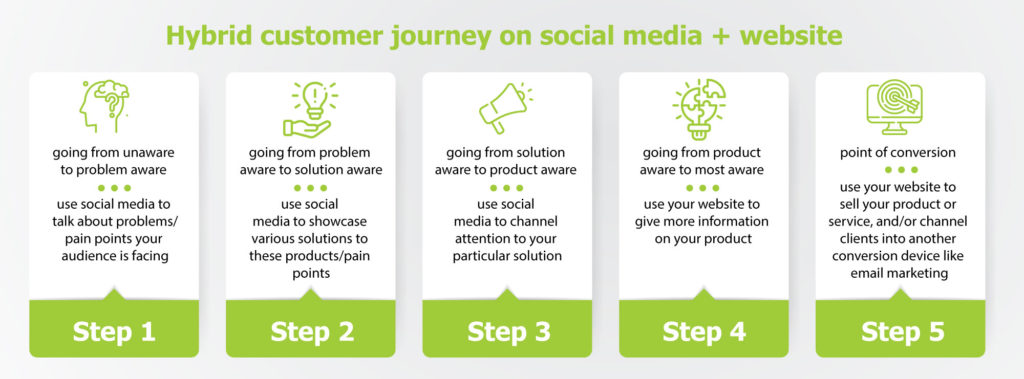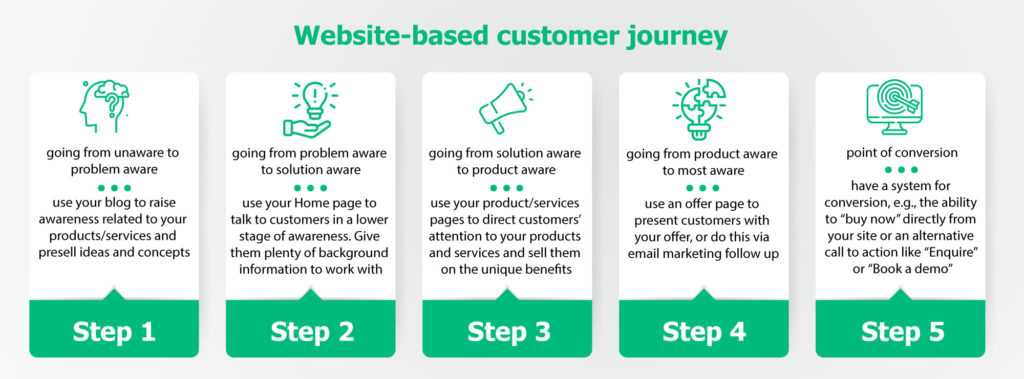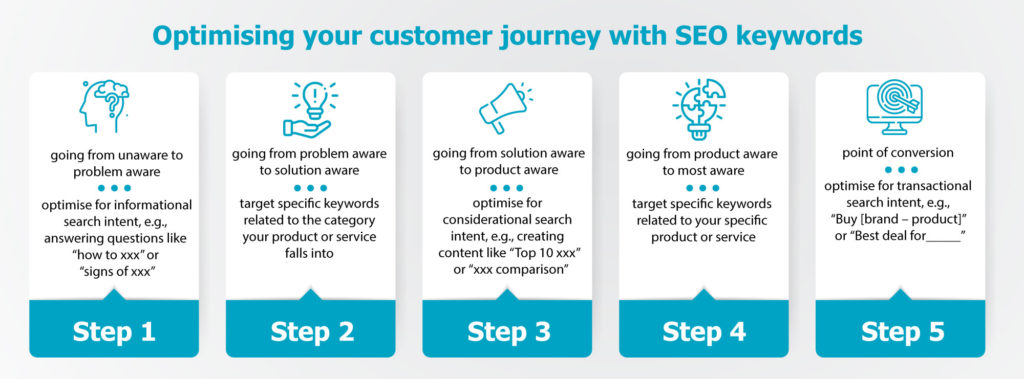Have you ever landed on a webpage and felt immediately drawn in? Overcome by a sense of “Yes! These guys really get me!”
If so, you’ve experienced first-hand the power of a well-designed and executed customer journey.
This type of journey not only helps you build a strong relationship with your audience but also greatly increases your chances of conversion.
So let’s take a look at how you can nail your website’s customer journey.
The key is to meet your clients exactly where they’re at when they first encounter your website and guide them forward from there, step by step, all the way through to conversion.
This involves designing a path through your site that serves up the right information (we’re talking stories, benefits, pain points, etc.) in the right level of detail at the right time.
But how do you identify the right information or pinpoint what will help them move forward?
This comes down to understanding their stage of consumer awareness and targeting your website copy accordingly.
How the stages of consumer awareness relate to your customer journey
If you’ve been around the marketing block for more than a few minutes, chances are you’ve heard of the five stages of consumer awareness. (Otherwise, you can read about them here.)
To recap, the stages of consumer awareness are Unaware, Problem Aware, Solution Aware, Product Aware, and Most Aware.
These are the steps your clients need to go through before buying your product or service, so they’re also the foundation of your customer journey.
If someone is still in an early stage of awareness and you hit them over the head with a sales pitch, chances are they’ll run for the hills. Conversely, if someone is ready to buy (most aware) and you confront them with a long-winded explanation of features and benefits (when all they needed was a compelling offer), you’ll also miss the mark.
Rather, aim to move clients along the awareness spectrum one step at a time.
If you look at it this way, your customer journey is a five-step process:
- Step 1: going from unaware to problem aware
- Step 2: going from problem aware to solution aware
- Step 3: going from solution aware to product aware
- Step 4: going from product aware to most aware
- Step 5: point of conversion
So now let’s take a look at how to map this across to your website…
Mapping your customer journey to your website
To map your customer journey to your website, you first need to identify the role your website plays within the journey. Ask yourself what happens before someone lands on your site, and what happens afterwards.
This will help you position your messaging in a way that appeals to and resonates with your website visitors.
Example: Hybrid customer journey on social media + website
For example, if your company is very active on social media, then perhaps this is where you walk clients through the first three steps of the journey. If that’s the case, your website takes over at step 4, which means that your messaging can be targeted at product aware customers.

You don’t need to spend a lot of time (words) explaining your idea, product, or service because your audience already knows these things. They’re at the point in their journey where they’re tossing up options to figure out what’s best for them.
Speak to that!
To nudge these clients along their customer journey (and into the next stage of awareness), showcase your product/service and its many benefits in an appealing way.
Once your clients have reached the most aware stage, you need to have a system in place for conversion. This might be another page on your website, where you present a compelling offer, or it could be through another channel like email marketing.
Example: Website-based customer journey
Conversely, your website might be your main lead acquisition tool, which means it needs to do all the heavy lifting and walk clients through all stages.
If this is the case, it’s a good idea to dedicate different pages on your site to different steps of the customer journey.
For example…

Again, look at the customer journey as a whole and then pinpoint which parts of the journey your website covers.
Ask yourself: What came before it, and what comes after it? This will help you best position your brand message each step of the way.
Optimising your customer journey with SEO keywords
No matter how you want your clients to come across your website, chances are a fair few will discover you on the search engine results page.
This is an important consideration when you design your customer journey because you’ll want to optimise each page of your website for the SEO keywords that are most aligned with the stage of awareness the page was written for.
That way, visitors clicking through to your site from the search engine results page will be met with the same delightful experience of, “Yes! These guys really get me!” as the visitors you direct to your page from other channels.
If your search engine visitors are delighted by your website content, they are less likely to “bounce” back out of your website, and more likely to spend time on your page. This, in turn, helps Google recognise your website as a helpful and valuable resource, which improves your search engine rankings.
So here’s a quick overview of how to keyword optimise your website pages to correspond to your customer journey:

Targeting the right SEO keywords based on your visitors’ stage of awareness, helps you align the message and content of each page to your clients’ expectations. This, in turn, creates a seamless and enjoyable customer journey.
To have the best shot at ranking for your chosen keywords, you need to use them strategically throughout your content. You can find detailed guidelines on how to keyword optimise your website here.
Optimising your customer journey by improving usability
As the name implies, the customer journey is, well, a journey. In other words, your customer is going somewhere, and it’s your job to help them arrive (intact and in good spirits).
To help your customer get where they want to go, you need to provide the map and make sure they know how to use it!
It’s a good idea to map out all the different paths a visitor can take through your website and ensure that they are clearly signposted with links, buttons, and specific instructions on what to do next.
You’d be shocked at how many websites simply leave their customers hanging at the bottom of a page – no call to action, no button to take them to the next step, often not even a button to return to the top of the page. Nothing. Zilch. Nada.
Not surprisingly, this utter lack of guidance can bring the customer journey to a grinding halt (and severely impacts conversions).
Ways to improve your website usability
To avoid disrupting your customer journey, it’s imperative to consider usability. Aside from laying out and signposting clear paths for your visitors to follow, you can improve your website’s usability by:
- Reducing complexity: Make your website easy to use; group items logically; use visual elements like headlines, sub-headlines, and bullet points to guide visitors, and make your messaging clear
- Have clear calls to action: Tell your visitors what to do next and set clear expectations for what happens when they take that action
- Ensure your links are working: Nothing disrupts a smooth journey like 404 errors and broken links. The last thing you want is to lose potential customers to tech glitches, so ensure that your links and pages are working smoothly
- Provide rich information: Don’t be afraid of using “too many” words on your site out of fear that no one will read them. Words don’t kill conversions (quite the opposite), only the wrong words do. Make your message compelling by using engaging language and proven copywriting formulas, and by avoiding empty phrases and marketing fluff
- Use intuitive navigation: Don’t make your readers look for things in hidden away places. Make information easy for them to find and access, and consider adding elements like a search box, FAQs, live chat, or a prominently placed phone number so they have various options for finding out more
Wrapping up
There are a number of things to consider when designing the ideal customer journey for your website:
- What role does your website play in the sales & marketing process?
- Which stage of awareness is your client in when they land on your site?
- Are you using SEO keywords to attract the right clients to the right pages?
- Which paths can customers take through your site and how can you improve these?
- How can you improve the overall usability of your site to make for a better customer journey?
By answering these questions and integrating your takeaways into your customer journey, you’ll delight your customers and build meaningful relationships between your customers and your brand.
In short, you’ll be the brand who “gets” them (figuratively and literally).
If you have any questions, please reach out to us at [email protected] We’d love to hear from you, and we’re here to help!
If you want to build brand awareness, authority, and trust, your best bet is to start by nailing your brand story.
Whenever you are ready, there are 2 ways we can help you do that:
- Join The Storydriven Marketing Academy: Our FREE course that teaches you how to consistently nail your messaging across all brand assets
- Enquire about our Brand Storytelling Workshop: We work with you 1:1 over four guided workshop sessions to craft your storydriven brand messaging & content strategy
